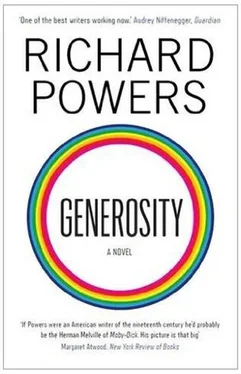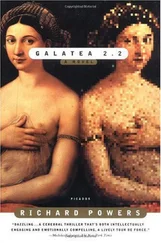She snickers, as she sometimes does during the show’s more outrageous segments. “I can see that. You guys are all over these smart drugs already, aren’t you?” He doesn’t, she notices, deny it. “Unfortunately, almost forty is the new early retirement.”
She walks back through the quarry-stone-and-cedar living room, past the shelf of pictures of the ex-wife and two kids, each already on their way to becoming multimillionaires. She grabs her bag and keeps walking. He follows her back out to the Camry. He doesn’t try to touch her.
At the car, arm’s distance, she tells him, “Thanks again for all the cooperation. This will be one of our better shows. You make fantastic television.”
He stands there, open as ever, ready for the next big thing. His crinkled face would simply like to discover what drives her. Born researcher. He may not have the happiness gene, but he possesses an ebullience she finds more attractive than beauty.
“You should stay a little,” he decides. “I’m telling you. You never know what might make you glad.”
“True, that.” She wants to beg him not to cure melancholy, not for another century or two, anyway. She hears the nocturnal creature call again, from up in the tomb of woods. She puts a hand on Kurton’s shoulder, pecks his pursed lips, opens the car door, and is gone.
She’s seven miles down the winding, dark road when story crashes over her like a whitecap. She pulls off in front of a trim saltbox store whose laddered signage reads:
GROCERIES
GIFTS
BAIT
UNITED STATES POST OFFICE
She fishes in her bag, finds the phone, and-something she never does-pulls back onto the road even while hitting the speed dial. Nicholas picks up. “Hey,” she says. “It’s me.” Whoever that may be. “I’m on my way. Get your hundred dollars back from Pomade Boy. And listen. We need to do one more show on this. Exactly. You’re a mind reader. I can’t imagine she’ll be too hard to hunt down.”
She says goodbye and snaps the phone shut, feeling grim and purposeful and halfway to vague exuberance.

Creative nonfiction comes down to this: science now holds routine press conferences. As the article hits print, Truecyte orchestrates their announcement about the network of genes that helps regulate the brain’s set point for well-being. The few dozen science writers, photographers, lawyers, and investment researchers who show up for the Cambridge event know the drill. All the actors in the network adjusted to the fact ten years ago: genetics has become genomics. Science has long since passed beyond the realm of wonder into entrepreneurship. New biochemical properties mean new intellectual property. Nobody mobilizes this much apparatus or lays in that much catering unless they mean to recoup it many times, down the line.
The mobile crew of Over the Limit is there, of course. And if history ever needs it, they have forty-five minutes of raw video proving that Thomas Kurton is not the first to use the instantly notorious term. That honor belongs to a sixty-five-year-old geologist turned reporter for one of the last popular-science glossies not yet driven to extinction by the Net. It happens at around the thirty-eight-minute mark, after Kurton has talked through his slides, run his animations, and spoken about “a new era in our understanding of the foundations of emotion.”
First, there’s an erudite question from a wire-service newbie about the ways in which other flavors of 5-HT receptor genes might be implicated. A veteran public-radio reporter asks about the penetration: What percentage of people with these alleles will actually be extremely buoyant? Someone else wants to know what role micro- and macroenvironments play in getting these genes to express. Kurton just shrugs and admits that the hard questions are still at large.
Then the former geologist and soon-to-retire magazine writer uses the term that everyone else was going to report anyway. “Are you telling us that you’ve found the happiness gene?”
“No,” Kurton says, the cameras catching his pained frown. “We’re not saying that at all.”
It’s like Jesus commanding his apostles not to let on about the Lazarus thing.
“What exactly are you saying?” Something about the science writer’s delivery makes the whole room laugh.
Kurton takes his time. “We’re saying that we’ve measured a very strong correlation. People with this grouping of key gene variants will be far more likely to enjoy elevated affective set points than those who do not. All other things being equal.”
All other things are never equal. But before anyone can point out that impossible catch, the éminence grise from the Times asks if the study has pharmaceutical or clinical implications. A grinning Kurton replies, “It might!” A sardonic chuckle issues from the audience, as they realize that’s his final answer.
Schiff raises her hand. Kurton doesn’t seem to recognize her as he takes her question. “Your hyperthymic subject the one with the optimal combination? How many others like her would you say there are, walking around out there?”
Kurton can’t suppress a covert grin. “We need more data on the frequency of alleles in different populations and the way they assort with regard to one another. Akiskal estimates that about one in a hundred people in the general population meet the research criteria for hyperthymia. If you forced me to guess right now, I’d say about one in ten thousand of those already fortunate subjects are also immune to unstable negative moods and intemperate behavior.”
She does the math. “So roughly one in a million?”
His grin fades, unsure where she’s going. “You could put it that way.”
She means to ask: Why is the “optimal” configuration so damn rare? What doesn’t natural selection like about it? Why should perfect bliss be hundreds of times less common than cystic fibrosis? But she misses her chance, and the rest of the conference plays out in variations on: How soon can you make the rest of us feel a little better?

Even those journalists who use a question mark in their headlines barely disguise their excitement. Science has found a chief genetic contribution to bliss. Genomics now knows what combinations of inherited material help lower negative affect and raise positive. Happiness gene identified? Did you think it would evade detection forever?
The Alzheimer’s gene, the alcoholism gene, the homosexuality gene, the aggression gene, the novelty gene, the fear gene, the stress gene, the xenophobia gene, the criminal-impulse gene, and the fidelity gene have all come and gone. By the time the happiness gene rolls around, even journalists should have long ago learned to hedge their bets. But traits are hard to shake, and writers have been waiting for this particular secret to come to market since Sumer.
The wire services each run their own account, reaching a whole rainbow of conclusions about what, if anything, the new findings mean. The 1,100-word Science Times article makes only five to seven errors, depending on who’s counting. Newsweek puts the story on their cover: Better than sex, stronger than money, more lasting than prestige The secret of happiness? Be Born Happy . Page 28of the same issue is an ad for a drug company with a substantial financial interest in Truecyte.
Two of the big-four late-night comedians incorporate the story into their monologues:
So science has finally discovered that happiness is mostly inherited. But just remember, these are the guys who discovered that sterility may be inherited It’s interesting that, for some reason, the happiness genes aren’t particularly widespread. Not as widespread as, say, the obesity gene. Now the obesity gene: talk about wide spread
Читать дальше














